theory of color
There is 100% NOTHING WRONG with hyperpigmentation, our melanin must shine.
However, color correcting it before application makes a hell of a difference - it’s usually one of those key differences in what a professional artist does, that you might not do at home.
For color correcting, remember the principle of using the opposite color on the color wheel to neutralize.
For dark circles, if they appear blue or purple (common in fair to medium skin), use a peach or orange corrector; if they lean more brown (common in deeper skin tones), opt for a deeper peach or reddish-orange.
For dark spots (hyperpigmentation), which often appear brown or reddish, use a peach, orange, or even a green corrector to neutralize redness within the spot, depending on your skin tone and the spot's undertone.
Apply correctors sparingly to the specific areas before your foundation or concealer for an even complexion.
Remember, Not Too Much!
You can use the pale YELLOW to even out any mild redness. Another good strategy for lighter girlies, utilizing a GREEN color corrector. You can use a green pigment if you have intense redness, that will cancel out. A PURPLE pigment if you’re medium toned and want to cancel some dullness, or minor dark spots. A BLUE pigment to neutralize any color or shade, in the event you end up wearing a foundation or concealer that isn’t the correct undertone (too orange).
Again, affirm to yourself there is 100% NOTHING WRONG with hyperpigmentation, our melanin must shine through sometimes!
Just maybe not when we’re in a full glam! Here are some solution based options:
Illuminating Primers:
Apply these before foundation and often contain finely milled pearls or light-reflecting particles that create a subtle, radiant base.
Radiance-Boosting Moisturizers:
They might contain subtle shimmer or light-diffusing properties to make the skin appear more luminous.
Liquid/Cream Highlighters:
These are concentrated products with a strong illuminating effect. They can be mixed directly into your foundation or moisturizer for an all-over glow, or dabbed onto the high points of your face (cheekbones, brow bone, bridge of nose, Cupid's bow) after foundation for targeted radiance.
Glow Drops/Serums:
These often come in dropper bottles and can be used in various ways – mixed into skincare or makeup, or applied directly.
Shimmer Body Lotions/Oils:
While often used on the body, some lighter versions can be carefully applied to your chest or arms for a little shimmer action.
A bronzing sunscreen is a product that combines the protective benefits of sunscreen (SPF) with a cosmetic tint or shimmer that gives your skin an immediate, temporary sun-kissed or bronzed appearance.
Unlike self-tanners that develop over hours, these provide an instant glow or subtle color upon application, allowing you to achieve a tanned look while simultaneously protecting your skin from harmful UV rays.
Here are three important things to consider when buying a sunscreen for makeup application:
No White Cast:
this is crucial, especially for deeper skin tones, as a white cast can make your foundation look ashy or unnatural. Look for chemical sunscreens or mineral sunscreens formulated with micronized zinc oxide and titanium dioxide because they blend way easier
Finish and Texture:
If you’re going for a dewy, matte, or natural finish. A dewy sunscreen can enhance a glowy makeup look, while a matte one is better for controlling oil and ensuring your makeup lasts longer.
Compatibility with Makeup:
Ensure the sunscreen layers well with your other makeup products (primer, foundation, concealer) without pilling, streaking, or causing separation.
BY LAUREN MACKEY - MADEBYDLFCE, DLFCE LLC.
MAKEUP 4 THE MODERN DAY DOLL
WWW.MADEBYDLFCE.COM


